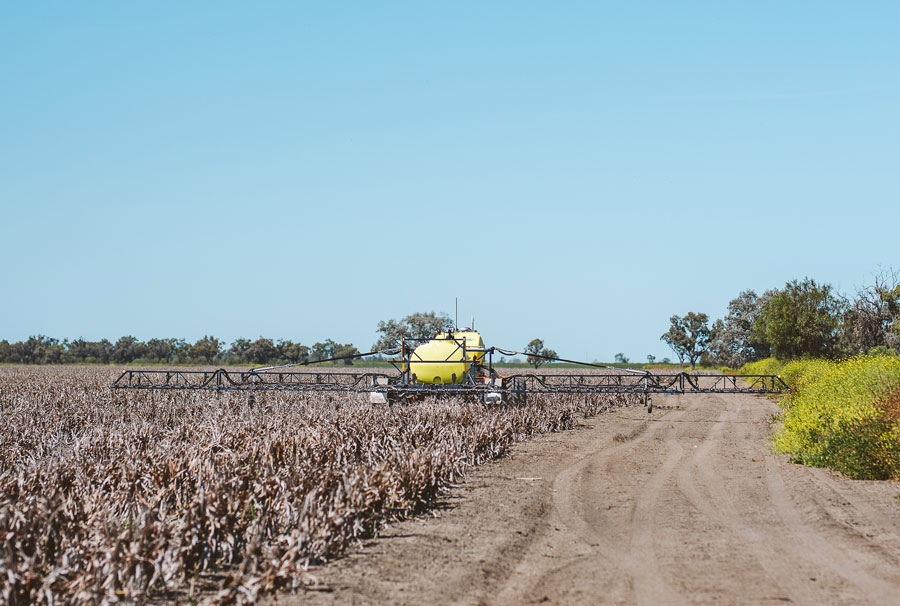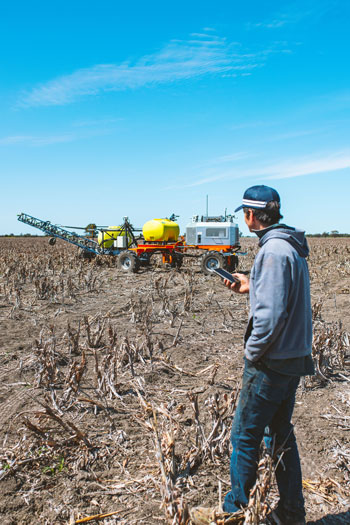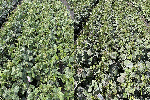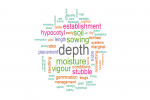Key points
- Charlie and Elsie Buchanan have been using a SwarmBot from SwarmFarm Robotics since September 2023
- It is expected to pay for itself over three years
- Charlie uses an 18-metre Hayes boom spray with new generation WEED-IT and a Boris 76 SwarmBot
- The Buchanans estimate the SwarmBot has saved them at least $185,000
A change of plan to replace a new spray rig with an autonomous alternative has saved New South Wales growers Charlie and Elsie Buchanan up to $185,000 in chemicals, labour and fuel
Comparing the cost of chemicals, labour, fuel and depreciation for a self-propelled spray rig to the SwarmBot camera sprayer combination, New South Wales grower Charlie Buchanan estimates he has saved at least $185,000.
Those calculations are based on four-pass camera-guided double knock sprays at $12 per hectare from December through to mid-April, compared with three passes of broadacre spray at $26.40/ha.
Charlie, who farms at ‘Come by Chance’, was persuaded to buy a SwarmBot from SwarmFarm Robotics in 2023 after seeing a neighbour’s SwarmBot in action.
He had intended to trade in a Goldacres dual-line boom fitted with WeedSeeker® sensors for a new 36-metre Hayes dual-line system with WEED-IT cameras, but switched to an 18m Hayes boom spray with new generation WEED-IT and a Boris 76 SwarmBot, all for a similar price to what he would have paid for the 36m boom alone.
Charlie is a third-generation grain grower whose grandfather, Max Buchanan, was among the district’s cropping pioneers in the 1950s. With his wife, Elsie, Charlie recently took over ‘Bungle Gully’, a 13,350ha mixed farming operation, from his parents Bill and Fiona.
About 60 per cent of ‘Bungle Gully’ is cropped. Winter crops include fodder barley varieties such as Moby, and wheat, chickpeas, canola and faba beans for grain. Summer crops are forage sorghum, grain sorghum and dryland cotton.

The SwarmFarm bot named Boris in a sorghum stuble paddock spraying weeds around headlands. Photo: Kirsty Fisher
Calculations
Charlie says the SwarmFarm decision has already proven its worth. The kit arrived in September 2023 and he expects it to pay for itself within three years.
Ideally, he would like to be able to run the SwarmBot across the cropping area and complete the required spraying within a three to four-week period, which is achievable given 15 per cent is designated to summer crops.
The use of a second unit during time-critical periods in February to March would be beneficial for control of feathertop Rhodes grass, when double knocks are required.
The key to success, according to Charlie, is properly mapping paddocks at the outset, identifying the location of water troughs and tanks as well as trees, fences, headlands and internal roads.
Then you develop a work plan, pretty similar to how you’d normally spray a paddock, send that instruction to the robot and send it on its way. You can have as many paddocks as you want lined up as jobs for it to do.
The landscape is flat, perfect for an autonomous vehicle such as the SwarmBot.
 Charlie Buchanan operating the SwarmFarm bot, Boris. Photo: Kirsty Fisher
Charlie Buchanan operating the SwarmFarm bot, Boris. Photo: Kirsty Fisher
For Charlie, teething problems were minor. In his initial mapping of a fodder paddock with numerous trees, Charlie did not put the points far enough from the edge of the tree canopies.
“It was pulling up pretty much at every tree, saying, ‘Obstacle, obstacle, come and have a look at me’,” he says.
Fortunately, moving the unit when it becomes ‘stuck’ is relatively simple. Using a smartphone or tablet within 100m, it is possible to tap into the onboard wi-fi, activate manual mode and select forward or reverse, much like driving a remote-control model car.
As well as having a ‘dry plan’, Charlie says the unit will need a ‘wet plan’ to cope with heavy or extensive rain that can cause wet spots where the SwarmBot might become trapped.
“You just have to go around with a bike or a ute and map it out,” he says. “You can do it from the office if you know where your wet spots are. But you still have to check your paddocks before you send it on its way because they can get bogged.”
The maps can also include locations for where the SwarmBot can stop when it is running low on fuel or chemicals. An automatic refilling option is now available, but Charlie is happy to keep refilling manually for now.
This summer he plans to mix a batch of herbicide near the workshop and drive it out to meet the unit at a road or headland, so it does not have to waste time or fuel travelling to a fixed tank.
“I’d be happy to run a trailer to it and fill it up that way,” he says.
Charlie says the new technology has made a big difference already, identifying thumbnail-sized weeds in thick stubble, using less chemical because of fewer misfires, and saving on labour costs by being able to operate 24/7 at a maximum speed of 10km/h without needing a human worker to drive it.

























































